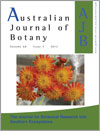Australian Journal of Botany
Volume 60
Number 7 2012
Phylogeography in plants is hampered by a lack of identified gene regions that detect sufficient variation in intra-specific lineages to reveal historical patterns. Variation was assessed for 13 chloroplast regions in six species where variation in the chloroplast genome is known from other markers, and a set of seven regions that were variable across lineages was identified. These sequences provide a useful basis for an informed selection of chloroplast regions for assessment of phylogeographic structure in plants.
Understanding seed germination and recruitment is important for managing long-lived plant species. Seed viability, timing and success of germination were investigated for a palm with fragmented populations. Good germination was achieved by burying fresh seed. Successfully restoring palm populations may need artificial seeding with management of grazing and seed predation.
Megaleranthis saniculifolia, a Korean endemic perennial species that bears beautiful milky-white flowers in early spring, is distributed in limited, fragmented areas and is exposed to risks of habitat loss. Markedly lower genetic diversity in fragmented populations within the marginal area compared with the central area was attributed to accelerated inbreeding and/or genetic drift. Because populations in the periphery are at risk of severe erosion of genetic diversity and local extinction, a special conservation strategy and management program is needed.
Ten species from six genera of Australian terrestrial orchids were successfully germinated on BM1 medium using asymbiotic techniques. The use of vital stains (TTC, FDA) to determine seed viability proved successful for two out of four species tested, with FDA generally providing a more accurate estimate of viability than TTC.
The responses of fir (Abies faxoniana) radial growth and recruitment to climate factors were explored in the Wanglang Natural Reserve. The results indicated that previous August mean temperature and January precipitation were the dominant factors determining fir radial growth, and recruitment was sensitive to spring–summer temperatures.
Two highly invasive Hieracium species have recently established in the Australian Alps, threatening biodiversity and agricultural productivity. We investigated their seed ecology, establishing that Hieracium produces large amounts of short-lived seeds that readily germinate with light and moisture, leaving little to enter the soil seed bank. These findings, together with the fact that seeds are killed by temperatures above 110°C, have important implications for the design of control programs that aim to eradicate the species.
The vegetative propagation of Ptilotus nobilis is limited because of its prolific and early flowering habit. Floral initiation was investigated by scanning and light microscopy and showed that flower initiation occurs as early as 22.2 days after germination.
Recently, molecular analysis caused the South American Viguiera species to be transferred to Aldama. However, the circumscription has not been established for certain of the South American species, including Aldama filifolia, A. linearifolia and A. trichophylla, which had previously been treated as synonyms because of their high similarity. The anatomical and chemical characteristics identified by the present study confirmed that the studied samples belong to three distinct taxa.
The reasons for the decline of a threatened plant with a small geographic range were investigated. It was found that it produced plenty of seeds but that no new plants were established because of high weed densities at the degraded sites. Small remnants therefore represent the ‘living dead’ and will need careful management to survive.
Cat’s claw creeper is a serious threat to biodiversity in riparian and rainforest communities in eastern Australia. Two varieties have been identified in Australia; one widespread and the other restricted. Our results indicate that the variety occupying a relatively small range may be a more successful invader and could thus become more become more prevalent in the future.




